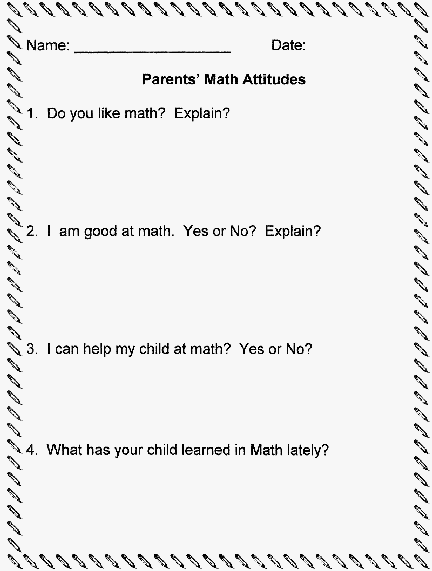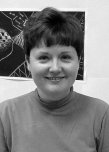

ACTION RESEARCH: ATTITUDE IS THE KEY TO SUCCESS
Heather Knill-Griesser
Grand Erie District School Board
We’re doing division now. And math is so much easier than in September when we started times-tables. I thought I couldn’t do it until I tried and I had faith in myself.
(Jessica- Grade 3 Student’s Math Journal Comment)
The need for students to succeed in math is essential in our increasing technological world. My action research project began with a review of the "Summary of attitudes of grade 3 students" in our school from the 1998 Grade 3 EQAO Provincial Assessment. I was concerned with the response to the following statements by the Grade 3 students:
- "I like mathematics." (Girls - 50%; Boys - 38%) 2);
- "I am good at mathematics." (Girls - 31%; Boys - 44%).
The way we teach math should be driven by what we value to be important. I wanted to bring my teaching practice closer to my value that "attitude is the key to success." My question for my action research project, therefore, became:
"How can I use quality math/literature materials to improve students’ attitudes towards math?"
Taking The Risk
I took a critical look at the way I was teaching math and the resources that were available to me. I wanted to design a complete math program that I hoped would improve students’ attitudes towards math and consequently their success in math. I envisioned a complete math program to include:
- use of quality resources;
- math/literature activity centres;
- problem of the day challenges;
- integration of math across the curriculum; and
math journals.
I attended BARN (Brant Action Research Network) sessions for information and peer support and learned how to use math/literature materials.
Math/literature materials were purchased and the corresponding activities were created. Ways to collect data were decided upon using teacher journals, teacher/critical friend voices, photographs, parent and student math attitudes surveys (See Appendix A and B), and student math journals.
The Process Began
I was not only interested in students’ math attitudes but also parents’ math attitudes. I designed a "Parents’ Math Attitudes Survey" and sent it home at the beginning of my project. Students’ completed a "How I Feel About Math Survey" periodically after the completion of various math strands.
My complete math program began with the use of quality resources. I used the Interactions 3 math texts (1995) and "Practice On Your Own" masters to support my math program. Students were encouraged to use manipulatives with each new skill taught and to complete assigned tasks. I felt it was important to reinforce and develop problem solving skills in math and daily problem of the day challenges were designed using Gage Mathematics assessment activities for Grade 3 (1999).
A component of each science and social studies unit that was created from the Ontario Curriculum documents included integration of math. Math was integrated into music, art, health, and computer technology lessons as well.
My question encouraged me to look for a creative way to teach math taking a literature-based approach. The first activities I developed to improve students’ attitudes in math were activity centres to accompany literature-based math packets from Wintergreen. The story which accompanied the math manipulatives was math based and the activities were designed to reinforce the math concept. I developed a math rubric to assess the students at each of the activity centres. Students rotated through the centres in groups of four and each student had his/her own copy of the story to read in a guided reading approach.
Student attitude surveys expanded to include math journals as the second term ended and students were confident in communicating using words.
Something is Missing?
My complete math program seemed to be missing something. I reviewed my "Parents’ Math Attitudes Surveys" and discovered I had not been addressing a very important issue; partnership with parents in math. One parent wrote, "Yes, I can help my child but I would like to learn how he is taught at school, so when he has homework, we can use the same system at home so math homework will be less confusing for him." Parents commented on "Friday File" comment sheets and "Report Card" comment sheets that they were unsure of the new curriculum when assisting their children. They wanted to play a more active role in the math program of their children, but were concerned about the process of helping them. I then realized that it was important to develop strategies to foster positive attitudes in math for both parents and students. I then adjusted my action research question as follows, "How can I use quality math/literature materials to develop programs to improve students’ attitudes and positive parent interaction in math?"
The Mathtotes take-home activities program by Sandy Woodcock (1995) was a resource which I was interested in developing for my classroom. Mathtotes is a mathematics lending library. Mathtotes are created using "Pringles Chips" containers with a mathematics game or activity inside. Included in the tote are all materials required to complete the assignment or game (worksheets, manipulatives, crayons, dice, counters, etc.) Mathtotes are divided into six strands including logic, geometry, numbers, measurement, patterning, and statistics and probability. Students and parents complete a Mathtotes evaluation sheet each week in their math journal. Mathtotes enable a parent and child to work together to build and strengthen positive attitudes towards mathematics. The concrete materials and game-like activities make the learning fun and reinforce important math concepts and skills.
Voices of Success
At our February BARN meeting, Cheryl Black stressed the importance of validating the success of your project using different voices. The BLD (behaviour/learning disabled) class is integrated into my program throughout the day. I asked the BLD teacher, Cindi Sharp, if she would comment on my class because she is often working in direct contact with each of my students.
Cindi wrote:
As the year has progressed, Mrs. Knill-Griesser’s grade 3/4 class, as a whole, has improved its attitude towards math. Students have become better risk takers and seem more willing to perform various math tasks. The different math centres and activities offered to them this year have presented math in a fun, non-threatening manner that has appropriately challenged their thinking while encouraging them to draw upon their various skills. These experiences have all contributed to help them improve their confidence in their math ability which in turn has lead them to have a more positive attitude towards math.
Cathy Theophilus, the educational assistant who assists in my class wrote:
When Heather first introduced geometric solids, her students were unable to share a lot of information about them. Through the use of hands-on study using a variety of learning strategies and different materials (e.g., solid wooden forms and the building of their own solids using paper and toothpicks), students became excited to share their new knowledge. Students demonstrated this by being able to answer a variety of questions and give demonstrations to others.
During December 1998 parent-teacher interviews Tanya’s mother commented that Tanya’s confidence level in reading and math had increased dramatically. This had resulted in an increase in her academic achievement results.
"Student Math Attitude Surveys" showed a definite improvement from September 1998 to February 1999. Twenty out of twenty-two students responded that they liked math in February compared to eleven out of twenty-two in September. Seventeen out of twenty-two students responded that they were good at math in February compared to eleven out of twenty-two in September.
Nick, a quiet, shy, reserved, and, "How fast can I get it done?" student was an enthusiastic participant in math journals. In his journal he wrote, "I think this math today is important because math is everywhere, like for example variety stores. Math sometimes is challenging, but I usually get it done. I like math. It’s fun but sometimes it stumps me. My sisters like math and I guess it runs through the family." When asked to respond in their math journals about their favourite math subject, Tanya wrote, "My favourite math subject is multiplication. When we first learned it, I was so frustrated. I panicked! But now I really, really like math."
Students are confidently completing problem of the day questions in math that are related to the real world. When asked to list things that had six, twelve, and sixty in their design, a student replied, "An ant has six legs. Roses are sold by the dozen. A large box of Timbits has sixty in them!"
Voices of Frustration
Responses on attitude checklists were a direct reflection on the reinforcement of the math skill at home. In my journal entry of February 24, 1999 I wrote, "Students are very apprehensive about completing multiplication worksheets. Although I have asked parents to assist students with multiplication facts at home in the past two newsletters, students are commenting that they are not receiving assistance at home. There were many groans when I asked students to write in their math journals about multiplication."
I was concerned that parents’ math attitudes may have a direct reflection on the attitudes of their children. On the "Parents’ Math Attitudes Survey" I asked the question, "What has your child learned in Math lately?" One parent responded, "That’s your job. You’re the teacher! DON’T YOU KNOW?" This student, unfortunately, did not show an improvement in his math attitudes.
Conclusion
I am confident that my action research has achieved success in the development of programs to improve students’ attitudes in math. My student attitude surveys have shown an improvement in students’ responses to liking math and being good at math. My peer teachers/critical friends have acknowledged a definite improvement in the attitudes of my students not only in math but also in their success in risk taking and problem solving. Student math journal comments are positive, incorporating reflection and relating in the responses. My own personal journal entries show growth in the development of positive attitudes in my students.
Next Steps
My Mathtotes lending library is in its’ infancy and it will be interesting to read parents’ comments to determine the success of parents and children reinforcing important math concepts and skills at home. I hope that this will encourage positive parent interaction in math. Curriculum planning continues to be developed with math integrated across the curriculum. The Teacher Librarian is now purchasing literacy books that reinforce math concepts and skills to add to our math/literature activity centres for every grade level. I will continue to reinforce my value in the classroom that "attitude is the key to success!"
References
Allen, Pamela. (1982). Who sank the boat? New York: The Putnam & Grosset Group.
Flewelling, Gary. (1999). Mathematics assessment activities. Toronto: Gage.
Hutchins, Pat. (1986). The doorbell rang. New York: William Morrow & Company.
Interactions. (1995). Toronto: Ginn.
Jonas, Ann. (1984). The quilt. Toronto: Penguin Books.
McNiff, J. (1998). Action research for professional development. Mississauga: Ontario Public School Teachers’ Federation.
Reid, Margarette S. (1990). The button box. Toronto: Penguin Books.
Schwartz, David M. (1985). How much Is a million? New York: William Morrow & Company.
Viorst, Judith. (1988). Alexander, who used to be rich last Sunday. New York: Aladdin Paperbacks.
Walsh, Ellen Stoll. (1991). Mouse count. Orlando: Harcourt Brace & Company.
Woodcock, Sandy. (1995). Mathtotes. Don Mills: Addison-Wesley.
ACTION RESEARCH: ATTITUDE IS THE KEY TO SUCCESS
Appenidx A

Appendix B

Bibiographical Note:
 Name: Heather Knill-Griesser
Name: Heather Knill-Griesser
Current Position: Grade 3/4 teacher, Graham Bell-Victoria School, Grand Erie District School Bd. Heather has recently accepted the position of Curriculum Assistant--Primary Division for the Grand Erie District School Board
Academic Degrees: Currently pursuing her Masters Degree at Brock University
Current Research Interests: In 1997, she worked with colleagues to complete action research entitled, "Improving early literacy through action research using guided reading strategies." Heather's second action research project, "Improving math attitudes through action research," resulted from an analysis of the "Summary of Math Attitudes of Grade 3 Students" in her school from the 1998 EQAO Grade 3 Provincial Assessment survey.
